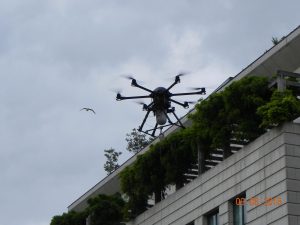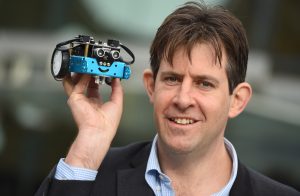Tethered Drone Systems raises £300K from robotics funder Britbots
Britbots, an organisation devoted to promoting the fortunes of UK-based robotics companies, has invested the first part of a £300,000 funding package for Cheadle Hulme’s Tethered Drone Systems.
Britbots operates the British Robotics Seed (SEIS) Fund and the equity crowdfunding platform, Britbots CROWD, which both support promising robotics-related businesses performing autonomous tasks on land, air and sea.
Dominic Keen, founder and CEO of Britbots comments: “Much is written about tomorrow’s world of driverless cars, where we are to be seamlessly whisked around by an all-pervasive fleet of unmanned road vehicles. However, the complexity of the road network and the high consequences of failure suggest that the public’s first experience of self-driving objects is much more likely to happen well away from roads; and human-beings probably won’t be the cargo.”
Drone On – Tethered Drone Systems (TDS)
Based on the South Coast, Tethered Drone Systems (TDS) builds unmanned multi-copters that can be used for aerial surveillance and broadcasting tasks. Whilst ordinarily drones have limited air time and must be remotely controlled by a pilot, TDS units are powered via a tether, so as to fly near-continuously. TDS engineers are working on building technology so that the vehicles can take-off and land by themselves. Currently the only UK based tethered drone in commercial development, and with a flight capability to 300m / 1000ft it will see a step change in operational activity.
 The company has recently received the initial part of a £300,000 funding package from the British Robotics Seed Fund to complete the development of a fully-commercial product and build the order book; and it is open for investments from interested members of the public via Britbots CROWD at: https://britbots.envestry.com/deals/1618
The company has recently received the initial part of a £300,000 funding package from the British Robotics Seed Fund to complete the development of a fully-commercial product and build the order book; and it is open for investments from interested members of the public via Britbots CROWD at: https://britbots.envestry.com/deals/1618
Jim Gibson, founder of TDS, says that, “pilotless tethered drones will be transformative technology not only for the security industry but also for precision agriculture, telecommunications and the emergency services plus many more applications”.
Dominic Keen of the British Robotics Seed Fund adds that “Tethered Drone Systems is great example of an autonomous device that is ready for operation today, rather than a piece of science fiction for the future.”
Waving not Droning – ASV Global
One company supporting Tethered Drone Systems’ is ASV Global. ASV Global has for the last seven years been making unmanned boats for customers such as the Royal Navy and the offshore energy industry. Their vessels perform tasks that would be too dangerous, too laborious or too expensive for more conventional shipping. Mark Exeter, Managing Director, ASV Global, said;
“We’re excited to be partnering with TDS, their technology has the potential to complement existing autonomous operations at sea giving greater visibility, enhanced communications and more data”. We look forward to working with them to unleash the potential of combining different types of robotic systems.”
 A bit of Rough – ZOA Robotics
A bit of Rough – ZOA Robotics
In addition to the unmanned activities in the air and on water, land-based technology is also being developed to allow autonomous vehicles to make inspections and move objects around uneven terrain, well away from the road network.
ZOA Robotics is one such company. Based in North London and also backed by Britbots, they are building self-operating four-legged robotics which are initially to be used to gather health and safety data in hazardous industrial locations, but in time will also be able to carry materials around building sites; and up and down stairs. ZOA Robotics is using the funds it has raised to test its technology with early-adopter customers in 2018.
Their founder and CEO, Thiago Azevedo, comments: “There’s a lot of hype about driverless cars at the moment but I think that we’re likely to see many other types of self-controlling mobile devices before fully unmanned automobiles become a reality.”
In summary, Dominic Keen observed that: “It is great to see UK-based robotics companies rapidly moving to develop and launch the next cohort of robots, delivering real value-add in the physical world.”






 Stay right up-to-date with TechSparx. Read North England (North West, North East and Yorkshire) regional business technology news aggregated and also written by us, all in one place on TechSparx. Curated and brought to you by TechSparx.
Stay right up-to-date with TechSparx. Read North England (North West, North East and Yorkshire) regional business technology news aggregated and also written by us, all in one place on TechSparx. Curated and brought to you by TechSparx.

